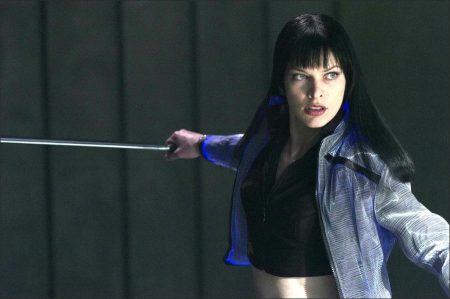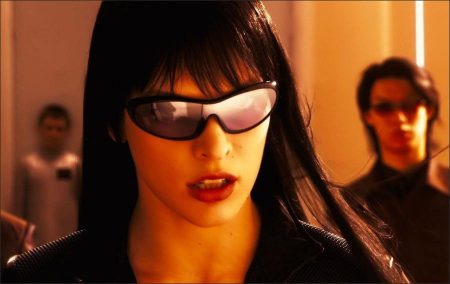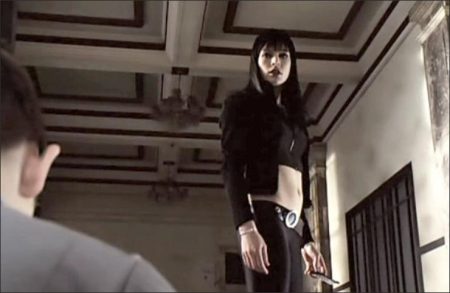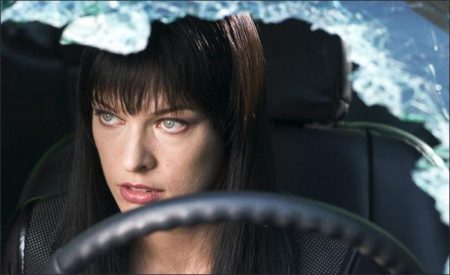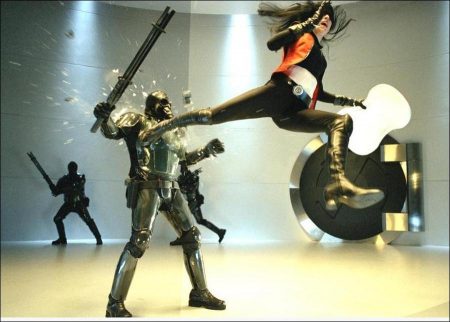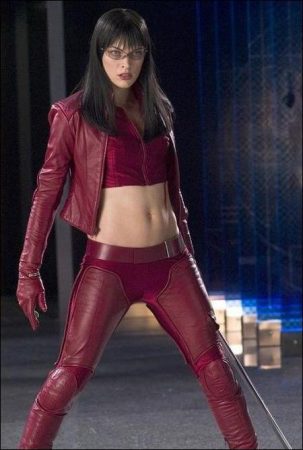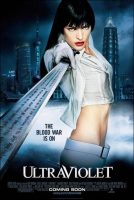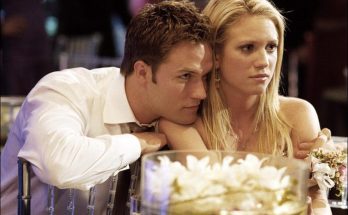Ultraviolet Movie Trailer. Wimmer’s innovative story and the multifaceted, imaginative world in which it’s set gripped everyone who read it, and producer John Baldecchi was one of the many eager to jump on board. “I thought Kurt did a great job of incorporating a multitude of powerful themes into a big action film,” says Baldecchi, “and he did it in a way that breaks the convention of the genre.”
Tony Mark, executive producer and second unit director, adds, “You have a woman who, because of her own loss and infection, has completely shut down emotionally. She’s a killing machine out seeking revenge in the little time she has left before the disease kills her, sublimating her emotions, her humanity, and her maternal instincts in pursuit of a single-minded course.”
With its dramatic scenes and martial arts set pieces, the filmmakers had to sign an actress who could handle the physical demands of the role while turning in an affecting, emotional performance. Fortunately, Wimmer wrote the role of Violet with only one person in mind and was lucky enough to get her to sign on for the role: Milla Jovovich. Wimmer knew that as an actress, Jovovich had the talent, beauty, and athletic ability integral to playing such a complex, fascinating and fun character.
“I fell in love with Violet,” says Jovovich. “I can relate to her. She’s like a comic book character, but I can relate to her as a human being and the problems she goes through, even though they’re extreme.” She was surprised at how quickly she got the part. “I met with Kurt and talked about it and told him how committed I would be. Then we basically shook hands and said ‘Alright, see you in Shanghai,’” she laughs.
Later, when she found out he’d written the role for her, Jovovich says it was flattering and exciting, and she clicked with director Wimmer immediately. “Kurt is such an exciting person to work with,” she says, “because he’s so passionate about this movie. He fell in love with this character, Violet, and was so excited about seeing her come to life.”
“She was absolutely spot on for this movie,” Baldecchi adds. “There’s a lot of inner strength in Violet, as there is in Milla, and working with her was a dream – she’s 100% dedicated.”
Shooting a gun backwards while doing the splits and spinning on one foot is no easy task…and that’s just one of the moves Violet has to master. To prepare for the role, Jovovich trained for a full year to get into shape, working extremely closely with stunt coordinator Mike Smith to hone the skills necessary to perform the style of fighting they had in mind. “We trained on an Olympic level, but it was worth it,” Jovovich. “I’ve never been involved with a movie much complex maneuvering, and never had such a long stretch of preparation time.”
Jovovich loved the experience of putting Violet’s story on screen. “The education I got on this movie, on a physical level as well as an emotional level, is really intense,” she says. “I’ve never been in this kind of shape before; I’ve never been as fluid in my life. I’ve always thought of myself as a big, clumsy oaf, so it’s amazing for me to learn and flip the swords and do these moves. I’m taking this with me for the rest of my life – I’d look at the screen after we were done with a scene and say, ‘Oh, my God. I did that. That’s me!’”
With Jovovich set for Violet, the filmmakers set out to cast the mysterious little boy character named Six. Wimmer auditioned hundreds of boys, but it was relative newcomer Cameron Bright who stood out. Bright had just completed two films, starring opposite Robert DeNiro in Godsend and Nicole Kidman in Birth, and it was the strength of his performances in those movies that convinced the filmmakers he could tackle the role.
“Cameron had the innocence needed to portray a 10-year-old who hasn’t ever been outside a four-walled white room and has had virtually no interaction with other people,” says Baldecchi. “The character doesn’t say a lot, so Cameron had to be able to express his emotions with just a look or a facial expression – and he does it beautifully. He has a wisdom beyond his years.”
Thankfully, there was an immediate connection between Jovovich and Bright that makes their onscreen pairing that much more effective. Having also started her career as a child, both modeling and acting, Jovovich empathized with Bright and understood how a childhood career can sometimes be difficult. “Cameron is smart as a whip,” Jovovich says, “and yet still a kid. We were always fighting and laughing. I tried to make it as fun for him as possible.”
For his part, Bright loved his new co-star. “Milla’s a great actor,” he says. “She’s very nice, cool, and funny – and you can talk to her about The Simpsons and stuff. She taught me a few things with kali sticks that she gave me, and her boyfriend gave me some guitar lessons.”
By choosing to help this mysterious child, Violet ends up with the government and the infected humans both desperate to stop her. She’s left with no allies but one: Garth. Played by William Fichtner, Garth is a member of this “new race” who lives in a traveling lab, desperately searching for a cure for the genetic mutation.
For Fichtner, director Wimmer was a main draw for his participation. “I’ve worked with Kurt before,” he says, “and if you know Kurt, you love to work with him. To really know him is to appreciate his intellect, because he’s absolutely one of the brightest people I know.”
Continuing to describe what appealed to him about the project, Fichtner says he was drawn by the action but it was the emotional core of the piece that really resonated for him. “It’s tremendous action, but to me what made it work ultimately is heart. Violet’s journey with Six – that’s what sucked me in.
“When you interject that sort of heart into a story,” he continues, “then you have something that’s worth telling and worth seeing.” Fichtner compares Garth’s feelings for Violet to those of a boy in high school who’ll do anything to please a girl and have her notice him. “She’s never gonna go out with you, but she might be your friend, if you’re lucky,” he laughs. Garth is willing to risk his own safety to help Violet because “he’ll do everything he can to be close to her, and really wants to protect her. I think Garth wishes she didn’t do some of the things she does, because they’re dangerous. But Violet is going to do exactly what she wants – and she does.”
As for his feelings on Jovovich, Fichtner says, “There was no one else to play Violet, absolutely.” He loved her work in Joan of Arc and says it’s the actress’ utter commitment to her roles that makes him respect her so much.
Fichtner also has high respect for Wimmer, and enjoys “the vision he brings” to a film. “It’s all in his vision: every set piece, every costume, everything. He wrote it and is very specific of what his intention is, the story he wants to tell.”
Action heroines need a great villain, and Ultraviolet is no exception. To serve as Violet’s nemesis, Wimmer dreamed up Daxus, a cruel government germophobic bigwig hellbent on retrieving Six. “Daxus is a bad guy with a sense of humor,” says Baldecchi.
Martial Art
To help create Ultraviolet’s eyecatching stunt sequences, the filmmakers hired stunt coordinator Mike Smith, who previously worked with Wimmer on Equilibrium. Their working relationship was tight and well-honed, with a shorthand that allowed them to collaborate with extreme efficiency.
Each of the film’s fight sequences have their own style and type of weapon – and each was incredibly complicated to capture on film. Thankfully, Wimmer and Smith were given the time and money in pre-production to take the time to create and choreograph each sequence. Months of work went into figuring out the most thrilling, unexpected ways to illustrate Violet’s talents, but the filmmakers were thrilled to be able to take the time to do it right.
“Conceptually, Wimmer is one of the smartest guys I’ve ever met,” says Smith. “He looks at action in a very different way than most. He has a great eye for it.” Smith has a degree in human movement and is a highly skilled martial artist himself. Using that knowledge, he wanted to create a unique style for the fight sequences that hadn’t been seen before. But in their early explorations nothing seemed a perfect fit for Ultraviolet. It wasn’t until they were watching rhythmic gymnastics one day when a spark of creativity occurred that ultimately gave them a foundation for a new style of martial arts.
“The sword moves in particular were derived from rhythmic gymnastics,” says Smith. “Kurt and I were amazed by what gymnasts could do with batons, ribbons, and balls. I was shocked no one had incorporated those skills in a film before.”
Having done stunt- and fightwork in several other films, working with Smith and Wimmer on the fight scenes was like a breath of fresh air for Jovovich. “I’m particularly proud to be a part of this production because of the quality of the stunts,” she says. “It’s really like dancing more than fighting.”
Smith was floored by her commitment. “Milla’s the most down-to-earth, hardest working actor I’ve ever been around,” he says. “She works her butt off. She’d take home whatever I taught her that day, come back the next day and it’d be better than before.”
Baldecchi was equally amazed. “To say we were impressed with her physicality is an understatement,” he says. “To swing a sword the way she does, to do the stunts she did – it’s been great fun to watch. She was absolutely tireless in training, and the movie benefited tremendously from her dedication and ability to execute what she learned.”
Seeing the Future
To create the futuristic world Violet inhabits, the filmmakers settled on production designer James Choo, fresh off the recent Hong Kong hits Infernal Affairs I and II. Because of its impressive, innovative architecture, China was chosen as the backdrop for the shoot and helped give a certain feeling to the whole project. Most of the stage filming took place in Hong Kong in a controlled environment over two months. The cast and crew then moved to Shanghai where they completed filming on location.
Shot in the Pudong district of Shanghai, Ultraviolet filmed in several different architecturally famous buildings, including the Jin Mao Tower. Standing at 1380 feet, it is the tallest building in China and the fourth tallest in the world, boasting the largest and highest observation deck. The 5-star Grand Hyatt Hotel, which fills the top 38 floors, hosts the world’s highest hotel rooms. Filming also took place at the Oriental Pearl TV Tower, the Science and Technology Museum, the Convention Centre, the Bank of China, and the Shanghai Information Centre.
“Defining this so-called ‘future world’ was a challenge,” says Choo, “how to unify the tone, the sets, the props, and even the cast so that every part fitted with the theme of the film and told the story.” Choo was greatful to be working with a detail-oriented director and writer. “Every scene in the script was clearly written and set out, which was a great help for me in creating the look of the film.”
The costumes were also crucial in grounding the film to a futuristic setting, and the filmmakers called on Joseph Porro to clothe the actors in a way that fit Violet’s world. “I love science fiction,” Porro says, “and this one had things in it I hadn’t seen before, which is a great creative challenge.”
Because of its comic-inspired look, Porro says he and Choo chose to work in blocks of color and concentrate on bringing those colors out. He also says it didn’t hurt to have Jovovich as Violet: “Milla’s all there, so I was very lucky to have her to dress. You don’t have to cheat anything with Milla – she’s got a great body.”
Dressing Jovovich could have had its challenges, Porro says. “Milla’s the kind of actress that could be a designer’s nightmare, to be quite honest. She’s doing a line of clothing on her own, she’s been around the fashion business, she’s intimate friends with many world-famous designers, and she’s done the whole fashion scene in Europe and the United States. She knows exactly what works.” But Porro found working with her a complete pleasure. “I liked the fact she totally gets it,” he continues. “She gets what works and what doesn’t and has a creative sense. She really brought something to the table.”
“Joseph is quite a character,” says Jovovich. “He’s just over the top, he’s wild, he’s an artist. He’s absolutely fabulous and I think you can see it in the movie. The costumes are like a futuristic Barbarella.”
Shooting in High-Definition
Ultraviolet was filmed entirely in the new high definition format using Sony 950 cameras. To date, the only other films shot on Sony 950 cameras are Star Wars II: Attack of the Clones and Star Wars III: Revenge of the Sith. Executive producer Tony Mark had experience in high-definition, having produced Once Upon a Time in Mexico (which filmed on an earlier prototype of hi-def camera), but it took a lot of convincing on Mark’s part to get both Wimmer and the studio to take such a calculated risk. Wimmer was eventually won over after visiting George Lucas on the set of Star Wars, who showed him high-definition’s scope and possibilities.
“Ultraviolet’s future world is highly designed and highly stylized, all of which plays to the strengths of HD,” says Mark. “With so many visual effects in the film, it was also hugely advantageous to shoot digitally. And from a financial point of view – the film stock, getting it developed and couriered back – we wouldn’t have been able to develop locally in China.”
Ultraviolet (2006)
Directed by: Kurt Wimmer
Starring: Milla Jovovich, Cameron Bright, Nick Chinlund, William Fichtner, Sebastien Andrieu, Ida Martin, Ricardo Mamood, Steven Calcote, Ricardo Mamood-Vega, Jennifer Caputo
Screenplay by: Kurt Wimmer
Production Design by: Sung Pong Choo
Film Editing by: William Yeh
Cinematography by: Arthur Wong
Costume Design by: Joseph A. Porro
Set Decoration by: Kim-Wai Chung
Art Direction by: Kwok-Wing Chong, Bernardo Trujillo
Music by: Klaus Badelt
MPAA Rating: PG-13 for sequences of violent action throughout, partial nudity, language.
Distributed by: Sony ScreenGems
Release Date: March 3 2006
Views: 340
